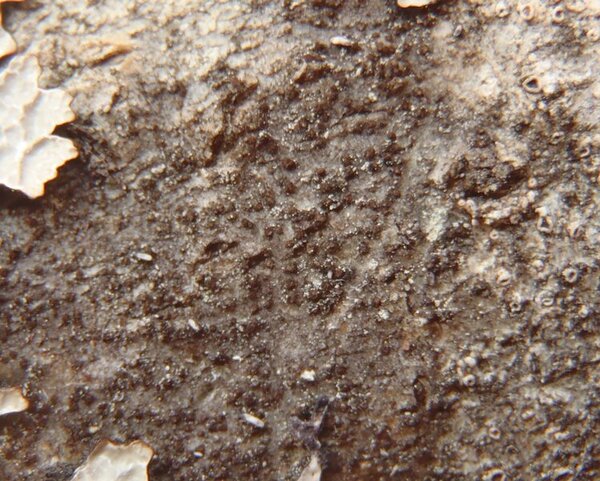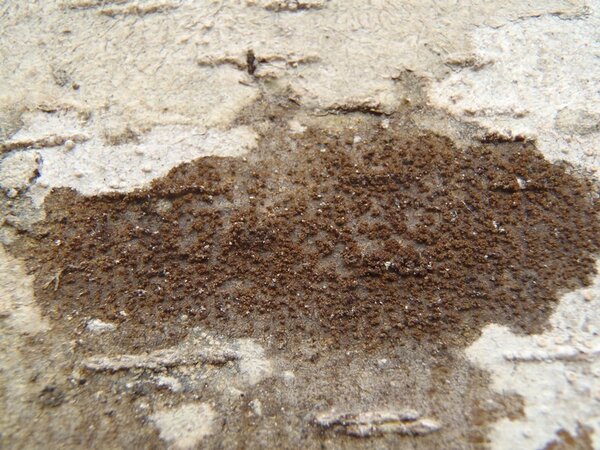Schaereria corticola Muhr & Tønsberg
in Tønsberg, Sommerfeltia, 14: 294, 1992
Synonyms:
Distribution:
Description: Thallus crustose, endosubstratic to thinly episubstratic, grey or pale grey-brown, usually forming small patches, continuous to areolate, sorediate, sometimes delimited by a grey-black, blue-black or brown prothallus. Areoles more or less rounded, strongly convex, up to 0.2 mm wide; soralia persistently punctiform, usually distinctly convex, up to 0.2 mm across, medium to dark brown due to pigmentation of the external soredia or greenish where the external soredia have been shed; soredia farinose, with a distinct cortex, 20-25 μm wide, the pigmented ones K+ fuscous brown, N+ reddish brown. Apothecia not always present, lecideine, black, epruinose, circular in outline, sessile, 0.15-0.3 mm across, with a flat to slightly convex disc and an up to 0.05 mm wide, finally often excluded proper margin. Proper exciple brown, but the rim green in upper part, greenish brown in lower part, containing crystals of gyrophoric acid (C+ red), the green pigment K-, N+ violet; epithecium green, rarely partly with a violet tinge, K-, N+ violet; hymenium colourless, 80-110 μm high, I-; paraphyses lax, sparingly branched and anastomosing in upper part, 1.5-2.5 μm thick, the apical cells up to 3 μm wide, surrounded by a pigment cap; hypothecium brown, of anticlinally arranged hyphae, 60-30 μm high. Asci cylindrical, thin-walled, with a single wall layer, not thickened apically, only the outermost gelatinous layer K/I+ faintly blue, discharge by splitting of the apex, Schaereria-type, with uniseriately arranged spores. Ascospores 1-celled, hyaline, broadly ellipsoid to subglobose, (10-)13-16(-20) x (8-)9-12(-14.5) μm, the wall 1-2 μm thick, surrounded by a gelatinous epispore. Photobiont chlorococcoid, the cells up to 12 μm wide. Spot tests: thallus and especially soralia K-, C+ red, KC+ red, P-. Chemistry: gyrophoric acid (major), lecanoric acid (traces), plus variable amounts of 5-0-methylhiascic acid.
Note: on bark of deciduous trees in humid sites, mostly in the temperate belts; widespread in the Holarctic region including Macaronesia, in Europe most common in the Northwest; reported from the Eastern Alps (Austria), but perhaps still overlooked elsewhere. To be looked for in Italy.
Growth form: Crustose
Substrata: bark
Photobiont: green algae other than Trentepohlia
Reproductive strategy: mainly asexual, by soredia, or soredia-like structures (e.g. blastidia)

Predictive model
Growth form: Crustose
Substrata: bark
Photobiont: green algae other than Trentepohlia
Reproductive strategy: mainly asexual, by soredia, or soredia-like structures (e.g. blastidia)

Predictive model
 Index Fungorum
Index Fungorum
 GBIF
GBIF





